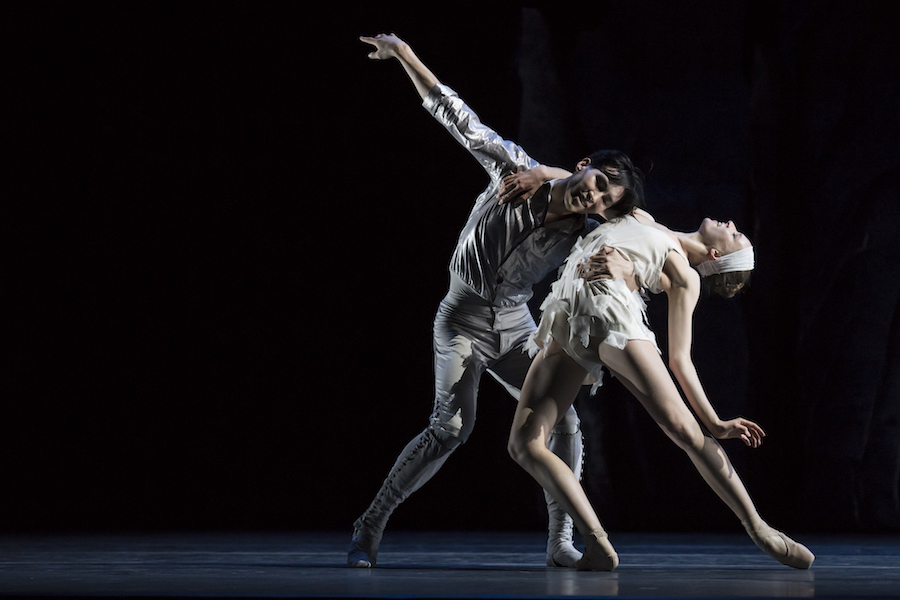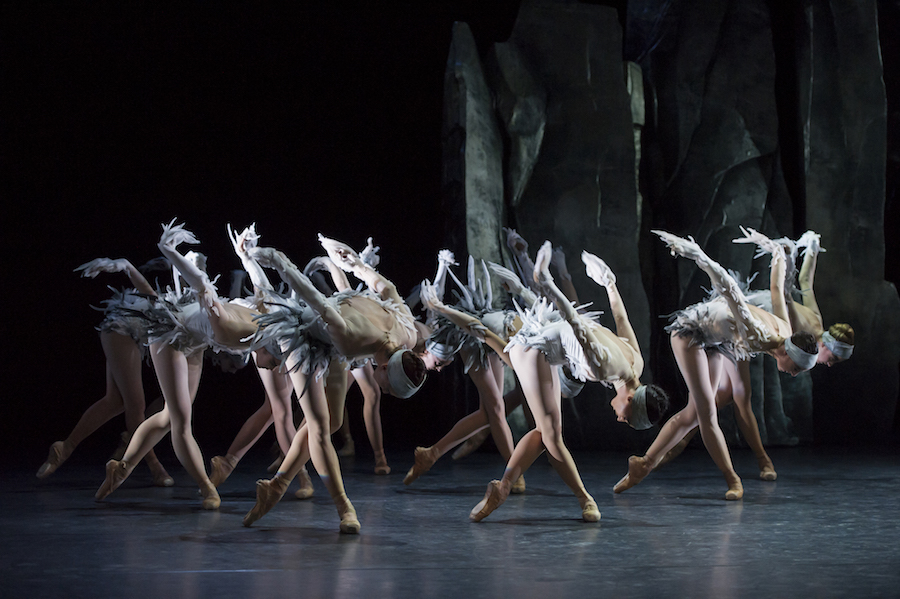Monte-Carlo is somewhere Melburnians would love to be at this chilly time of year, and on Thursday they basked in the glamour of the principality at the opening night of a short season of LAC, presented by Les Ballets de Monte-Carlo.
 LAC. Photos courtesy of Les Ballets de Monte-Carlo
LAC. Photos courtesy of Les Ballets de Monte-Carlo
Swan Lake is the Hamlet of the ballet world, constantly revisited and reinterpreted in an infinite variety of settings. This production was created by the company’s choreographer and artistic director, Jean-Christophe Maillot, in 2011. It is on stage here at the Arts Centre at the invitation of The Australian Ballet, whose artistic director, David McAllister, describes it as ‘astonishing.’
The prelude to Maillot’s offering was a short black and white film that set up the central drama between his cast of principals: the Prince, the King and Queen, the girl who becomes the White Swan, Her Majesty the Night and her daughter, the Black Swan. It was a surreal and sinister play-within-the-play, suggesting long-buried, hazy events, and it establishes the eerie other-worldliness that permeates the ballet.
There was a great deal of story to tell, and throughout the three acts the Prince remained at the centre of the drama in his quest for true love. He was danced by Matej Urban with clean, precise assurance in tightly complicated movement sequences and a likeable stage presence. The villain of the piece is Her Majesty the Night, and as in the original telling, she schemes to deceive him. Her entrance into Act One was a further glorious piece of surrealism as she came floating in atop an oversized black farthingale that was un-swirled by her Archangels of Darkness, a piece of action that had resonance later. She was danced by Anna Blackwell with malevolent glee, who also displayed superb control of the choreography. A mesmerising performer, she received an extra warm burst of applause at the end.
 LAC
LAC
Maillot sees the woman/bird trope as highlighting humanity’s primal nature as animals powered by instinct and aggression. The swans were not gentle and passive but strange and amoral, with swift jerking head movements and arms thrust back in a display of power. The White Swan (Lou Beyne) and the Black Swan (April Ball) were lovely to watch, and both dancers offered committed portrayals, but these roles were not strongly defined. The most fascinating element in Maillot’s story of base nature is the wicked mothers. Both the Queen and Her Majesty the Night displayed cruelty and jealousy. In an unexpected twist (spoiler alert), the Queen stabs and kills the Black Swan. A spine-tingling sequence ensued later when the Queen, head held high, led a stately procession across the stage in front of Her Majesty the Night, with the limp body of the Black Swan held above the heads of the courtiers. The body was left to hang upside down, lifeless, almost cruciform. Her pale skin against the black set and Blackwell pouring out her character’s unbearable grief below made for an affecting tableau.
The austere set design by Ernest Pignon-Ernest placed the action in an abstract, almost subconscious realm, and the lighting by Samuel Thery provided narrative texture by shifting the mood. There was beautiful colour also in the dancer’s costumes, and a stylish interplay of black, white and gold. The designer, Philippe Guillotel, reconceived the nature of the swans with a kind of tunic that made use of the traditional material of a tutu, tulle, to suggest feathers. It also displayed the lean muscularity of their legs. But the feathered gloves worn to symbolise the swans’ essential difference from humans distracted the eye by their awkwardness.
Maillot’s style is to integrate classical with modern movement to staccato effect. There were lots of steps but few long connecting phrases, with a corresponding loss of flow. As a company, the dancers executed the steps with metronomic precision, but the juxtaposition and rapidity of individual positions could be jarring. Blackwell and Beyne each worked their sinuous arms and supple upper backs to connect movements and they brought an elegance to sometimes ungainly steps. Maillot can create visually arresting moments, but the lack of lyricism in his aesthetic means there is little poetry or poignancy. The pas de deux in which the Prince and the White Swan fall in love, for example, did not have the dancing beauty that tugs at the heart, despite excellent performances.
For all that LAC aims to evoke humanity’s hidden drivers –the lake versus the castle, Dionysus triumphing over Apollo – the work is strangely cerebral, and I found myself more intrigued than engrossed. It was hard to feel deeply about the plight of the characters on stage, but the pace does quicken towards the climax and Act Three is the most compelling. The final moment was a cracker. A black cloth – recalling the extravagant swathe of fabric of Her Majesty’s farthingale – falls to the stage, covering the Prince and the White Swan. In that instant, mood, movement and music all came together in a rush of emotion and the auditorium gasped. It was spectacular, magnificent.
The last word goes to Tchaikovsky. Maillot had the score edited and rearranged for LAC, so it is not presented in the order familiar to ballet-lovers. Still, the music is sublime and maestro Nicolas Brochot and Orchestra Victoria gave an expressive account of its riches. In all, a satisfying excursion to a vibrant other-world, and then it was back out into the cold night.
LAC is at Arts Centre Melbourne until July 6











Comments
Log in to join the conversation.